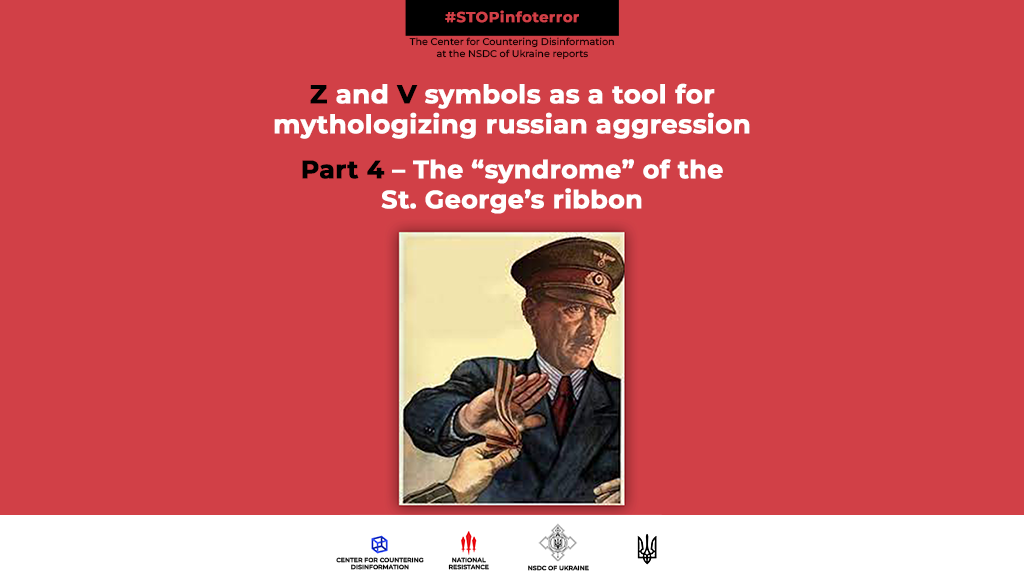The Center for Countering Disinformation reports that the use of the Z and V symbols in propaganda rhetoric is just a continuation of the russian practice of using historical monuments in patriotic education.
Falsifying history and presenting it in a favorable light has always been inherent in the russian mentality. Every more or less significant event in both russian and soviet history was “adjusted” to the worldview and actions of the leaders of a given time.
A striking example of this has become the “St. George’s Ribbon”.
This symbol has gone through many reincarnations in modern russian historiography. For the first time, the St. George’s ribbon was officially introduced by Catherine II on November 26 (December 7, new style), 1769, as an addition to the Order of St. George.
The tsarina sought to encourage the military’s “loyalty, bravery, and prudence for the good of the Russian Empire” in this way, which they had shown in the war against the Ottoman Empire. Over time, a whole range of awards associated with St. George was formed: an order, a medal, a cross, a flag, accompanied by a St. George ribbon.
According to the 1913 statute, it consisted of three black and two orange stripes. The traditional interpretation of these colors was that black meant smoke and orange meant flame.
During the Civil War of 1917-1921, the St. George’s ribbon continued to be used in the ranks of the White Guard armies as a symbol of resistance to Bolshevism and the struggle for a “united and indivisible” Russia. After the defeat of the White Movement, the St. George ribbon was actively exploited by various russian emigrant organizations, including those with a Nazi orientation, such as the Russian Fascist Party.
During World War II, in 1943-1944, a collaborationist “Union for the Struggle Against Bolshevism” operated in Bobruisk (now Belarus), whose symbol was a “St. George’s flag with a silver-embroidered St. George’s cross in the middle”. The St. George’s ribbon and the St. George’s Cross were also used by russian collaborative military units that fought on the side of Nazi Germany, such as General Vlasov’s Russian Liberation Army, the Russian Corps, and the Cossack Regiment.
No wonder the Soviet Union considered the St. George’s ribbon an enemy symbol inextricably linked to monarchy and empire until 1943.
However, in 1943, in order to raise russian patriotism in the context of the Second World War, the so-called guard’s ribbon was actively introduced, which outwardly reproduced the St. George ribbon of 1913 and was an addition to the soviet Order of Glory, and from 1945 was used on the soviet medal “For Victory over Germany in the Great Patriotic War of 1941-1945”.
In modern russia, the Order of St. George has been restored as a military award, with a corresponding ribbon. In 2000, St. George’s ribbon began to be introduced in the russian army and among the population. And in 2005, the St. George’s ribbon campaign was launched on Victory Day in russia.
At the same time, unnoticed by many, the term “St. George’s ribbon” was used in public rhetoric instead of the term “Guards’ ribbon”. Thus, instead of a symbol of war remembrance, the symbol of the aggressive and invasive policy of the Russian Empire returned. Therefore, it is not surprising that St. George’s ribbons were used with such excitement by pro-russian forces and terrorists in eastern Ukraine.
Independent Ukraine has nothing to do with this russian national symbol. In Ukraine, the St. George’s ribbon itself has become a symbol of the blatant falsification of Ukrainian history, a tool of russian propaganda, and another attempt to implant imperial and xenophobic ideas in the minds of Ukrainians.
The “Fifth Column” in Ukraine has always used the annual St. George’s ribbon hype as a pretext for confronting Ukrainian state symbols, despite the fact that in 2017 the Verkhovna Rada of Ukraine passed a bill banning the production and propaganda of St. George’s ribbons.
In the context of military aggression against Ukraine, the St. George’s ribbon, along with the Z and V symbols, continues to play a role as a kind of cover for putin’s failed domestic and foreign policies and is aimed at diverting the attention of russian society with pseudo-patriotic fetishes and slogans from the avalanche of socio-economic problems.
Let’s stop the enemy and #infoterror!










